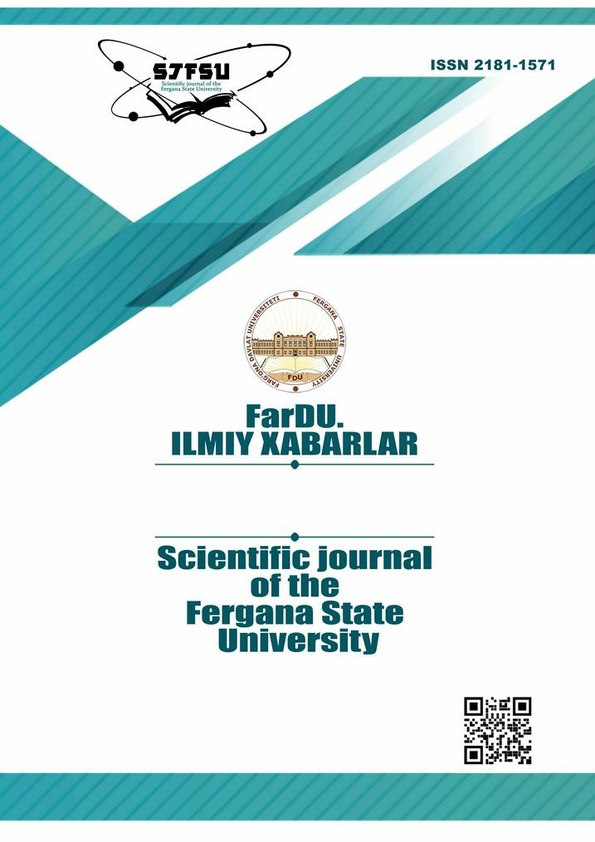MIXED EDUCATION – AS AN EFFECTIVE MEANS OF DEVELOPING INFORMATION-ANALYTICAL COMPETENCE IN FUTURE HISTORIANS
Keywords:
mixed education, information-analytical competence, distance education, traditional education, educational integration, teleconference communication programs, Internet and digital media, interactive, virtual education.Abstract
In this article, the origin of blended learning, different opinions and views about the term blended learning are discussed. Blended learning is considered as a new method of distance learning with the help of technology and the Internet in order to improve student learning, change the methods of teaching teachers, blended learning combines different models of traditional and distance learning, and It is argued that it is a learning strategy that uses multiple forms of technology.
References
Barbour M. History of K-12 Online and Blended Instruction Worldwideʼ. Handbook of Research on K-12 Online and Blended Learning. N.P., ETC Press Publ., 2014. – 516 p.
Bonk, C.J. & Graham, C.R. (2006). The handbook of blended learning environments: Global perspectives, local designs. San Francisco: Jossey‐Bass/Pfeiffer. — 624 p.
Clark, R.T., Mayer, R.E. E-learning and the Science Instruction. San Francisco: Preiffer, 2003. – 527 p.
Declan Byrne, Blended learning. http://www. trainingreference.co.uk/ blended_learning/ bldacg1.htm
Esyin Chew, Norah Jones, David Turner. Critical Review of the Blended Learning Models based on Maslowʼs and Vygotskyʼs Educational Theory, available at: http:// ihlsociety.org/ ICHL2008/ LNCSProceedings/ ICHL2008 Esyin Chew 14 pages. pdf (request date: 08.07.2020).
Friesen N. Report: Defining Blended Learning, available at: https:// www. normfriesen. info/papers/ Defining Blended Learning NF. pdf (request date: 31.06.2020)
Friesen N. Defining Blended Learning, August 2012, available at: https://www. normfriesen. info/papers/ Defining Blended Learning NF. pdf (request date: 21.06.2020)
Garrison, D. R., & Kanuka, H Blended learning: uncovering its transformative potential in higher education // Internet and Higher Education. 2004. № 7(2). – pp. 95–105.
Launer R. Five Assumptions on Blended Learning: What Is Important to Make Blended Learning a Successful Concept? // «International Conference on Hybrid Learning». Berlin: Springer Verlag Publ., 2010. – pp. 9–15.
Manya Suresh, V.Vishnu Priya, R.Gayathri. Effect of e-learning on academic performance of undergraduate students. Drug Invention Today | Vol 10. Issue 9. 2018. – pp. 1779-1800.
Martyn, Margie. The hybrid online model: Good practice // Educause Quarterly. 2003. № 26. – pp. 18-23.
Ruth Boelens (UGent), Stijn Van Laer, Bram De Wever (UGent) and Jan Elen. Blended learning in adult education: towards a definition of blended learning. Available at: https://biblio.ugent.be/publication/6905076 (request date:5.06.2020).
Stacey E., Gerbic P. Success Factors for Blended Learning, available at: http:// www. ascilite.org/ conferences/ melbourne08/ procs/stacey.pdf (request date: 5.06.2020).
Tomlinson, B. Blended Learning in English Language Teaching: Course Design and Implementation / Tomlinson B., Whittaker C. // British Council 2013. – 258 p. Available at: https:// www. teachingenglish.org.uk/ sites/ teacheng/files/pub_D057_Ble nded%20learning_FINAL_WEB%20ONLY_v2.pdf (request date:15.07.2020).
Watson J., Murin A. A History of K-12 Online and Blended Instruction in the United States. Handbook of Research on K-12 Online and Blended Learning. 2014. – 516 p.
Krasnova Tatyana Ivanovna. Soprovojdenie i podderjka deyatelьnosti studentov v smeshannom obuchenii. Available at: https://portal.tpu.ru/SHARED/k/KRASNOVA/science/Tab1/Guaidance%2 0and%20support.pdf (request date:10.07.2020).
https://www.christenseninstitute.org/ (request date:05.05.2020).
Procter C.T. Blended Learning in Practice, available at: www.ece.salford.ac.uk/proceedings/papers/cp 03.rtf (request date: 08.07.2020)
Downloads
Published
Issue
Section
License
Copyright (c) 2023 Scientific journal of the Fergana State University

This work is licensed under a Creative Commons Attribution-NonCommercial-NoDerivatives 4.0 International License.
How to Cite
Most read articles by the same author(s)
- Ilyosjon Siddiqov, PEDAGOGICAL BASES FOR THE DEVELOPMENT OF INFORMATIONAL- ANALYTICAL COMPETENCE IN FUTURE HISTORY TEACHERS , Scientific journal of the Fergana State University: No. 1 (2023): Scientific journal of the Fergana State University (Social humanities sciences)
- , HISTORICAL ARTISTIC WORKS FOR THE DEVELOPMENT OF INFORMATIONAL AND ANALYTICAL COMPETENCE OF FUTURE HISTORY TEACHERS AS AN IMPORTANT FACTOR , Scientific journal of the Fergana State University: No. 6 (2023): FarDU ilmiy xabarlari jurnali (Ijtimoy gumanitar fanlar)

